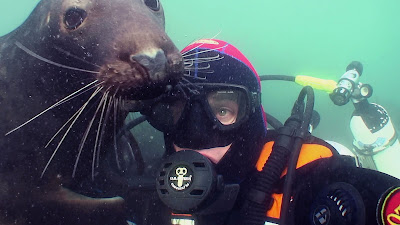bburville
Contributor
An excellent question and the counter argument used by most biologists - basicallly because without DNA proof - eg samples from both, it is impossible to prove that the pup is with their mother and not a unrelated adult (as you point out)
I have seen on more than one occassion a pup (probably 6-8 weeks old) with a female adult on the rocks - then enter the water together and indeed swim togther - in one such case the pup swam at times with the female adults front flipper touching her. In this same instance the adult female actually approached me at a depth of approx. 3m (10ft) having left the pup stationary in the water a few metres behind- breathing on the surface.
The female adult came over and interacted with me briefly whilst I remained stationary. ... as if to "check me out" and "assess any risk"
Moments later the female adult returned to the waiting pup and seemed to give the pup the "OK" to "play".... which it did ! Grabbing hold of my arm with it's front flippers and swimming around me at high speed darting and nuzzling with its nose.
After a few minutes the pup and female adult again adopted a swim together formation and swam off.
Now mother and pup??? or pup and unrelated adult??
Let me ask .... You see an adult suckling a pup on the shore... mother or another adult?? Answer - could be either as allosuckling has been recorded on many occassions with grey seals. Related - likely. Very new born pup with adult female on shore .... mother ... very likely BUT how can you prove this in the abscence of DNA tests??
Interesting....
safe diving,
Ben "Seal diver"
www.youtube.com/bburville
I have seen on more than one occassion a pup (probably 6-8 weeks old) with a female adult on the rocks - then enter the water together and indeed swim togther - in one such case the pup swam at times with the female adults front flipper touching her. In this same instance the adult female actually approached me at a depth of approx. 3m (10ft) having left the pup stationary in the water a few metres behind- breathing on the surface.
The female adult came over and interacted with me briefly whilst I remained stationary. ... as if to "check me out" and "assess any risk"
Moments later the female adult returned to the waiting pup and seemed to give the pup the "OK" to "play".... which it did ! Grabbing hold of my arm with it's front flippers and swimming around me at high speed darting and nuzzling with its nose.
After a few minutes the pup and female adult again adopted a swim together formation and swam off.
Now mother and pup??? or pup and unrelated adult??
Let me ask .... You see an adult suckling a pup on the shore... mother or another adult?? Answer - could be either as allosuckling has been recorded on many occassions with grey seals. Related - likely. Very new born pup with adult female on shore .... mother ... very likely BUT how can you prove this in the abscence of DNA tests??
Interesting....
safe diving,
Ben "Seal diver"
www.youtube.com/bburville




